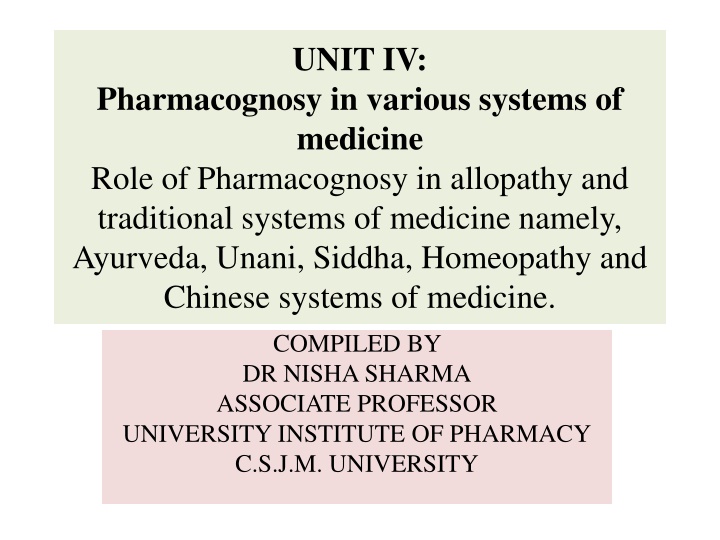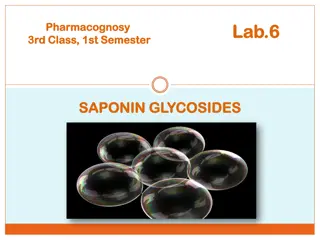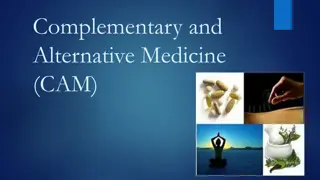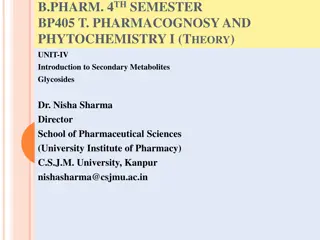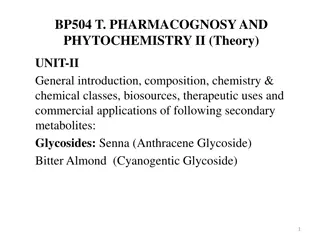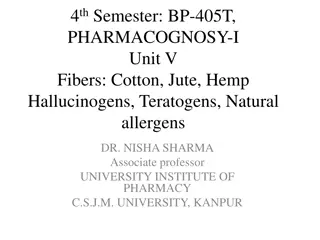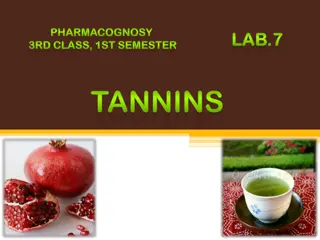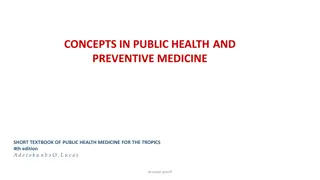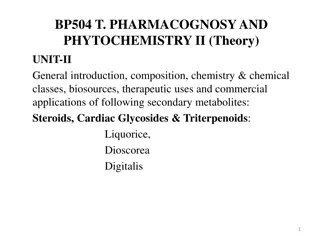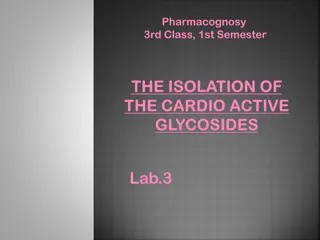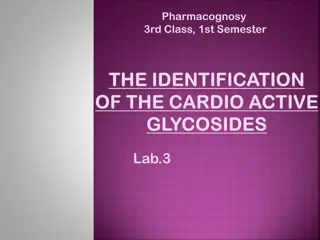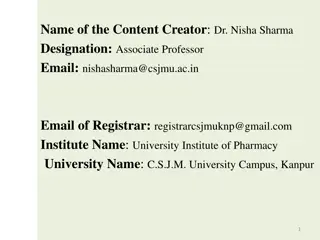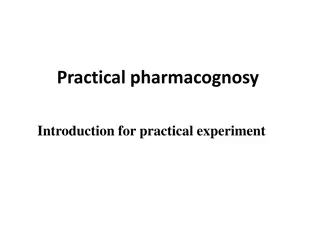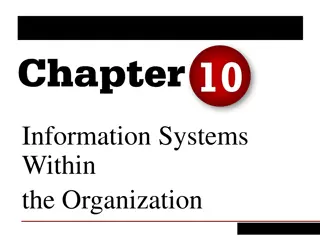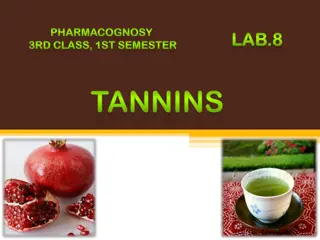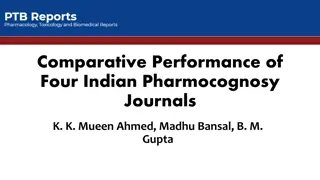Role of Pharmacognosy in Various Systems of Medicine
Pharmacognosy plays a crucial role in modern medicine like allopathy and traditional systems such as Ayurveda, Unani, Siddha, Homeopathy, and Chinese medicine. It involves the study of natural products obtained from plants, animals, minerals, etc., and their use in treating various health conditions in different medical practices.
Download Presentation

Please find below an Image/Link to download the presentation.
The content on the website is provided AS IS for your information and personal use only. It may not be sold, licensed, or shared on other websites without obtaining consent from the author.If you encounter any issues during the download, it is possible that the publisher has removed the file from their server.
You are allowed to download the files provided on this website for personal or commercial use, subject to the condition that they are used lawfully. All files are the property of their respective owners.
The content on the website is provided AS IS for your information and personal use only. It may not be sold, licensed, or shared on other websites without obtaining consent from the author.
E N D
Presentation Transcript
UNIT IV: Pharmacognosy in various systems of medicine Role of Pharmacognosy in allopathy and traditional systems of medicine namely, Ayurveda, Unani, Siddha, Homeopathy and Chinese systems of medicine. COMPILED BY DR NISHA SHARMA ASSOCIATE PROFESSOR UNIVERSITY INSTITUTE OF PHARMACY C.S.J.M. UNIVERSITY
Role of Pharmacognosy in allopathy Modern System or Allopathy Word Allopathy: derived from Greek word Allos which means other different & Pathy means suffering or disease. Used by Dr. Samuel Hahnemann (Father of Homeopathy) This system was developed in the Western countries. In this system drugs (tablets, capsules, injections, tonics etc.) are manufactured using synthetic chemicals and / or chemicals derived from natural products like plants, animals, minerals etc. This system also uses modern equipment for diagnosis, analysis, surgery etc. Medicines or drugs of this system is often criticised for its treatment of the symptoms rather than the cause of the disease, harmful side effects of certain drugs and for being out of poor people due to the high cost of drugs and treatment Role of Pharmacognosy in Allopathy is that Natural products isolated from plants/animals/marine/mineral acts as the major source for Modern Medicine. Ex: Taxol from Taxus, Digoxin from digitalis, morphine and codeine from opium, vincristine from vinca.
Role of Pharmacognosy in Ayurveda Ayurveda-Ancient Science of Life dated back to 5000 years in India. AYUR + VEDA= LIFE+ KNOWLEDGE OR SCIENCE It is described as science of life Ayurveda deals with the plant products, anatomy and physiology of human body, principles of treatment of diseases. Oldest Treatise of Ayurveda : Charak Samhita 1900 BC 341 plants Shushruta samhita: 600BC: Surgery in Ayurveda, 395 plants, 57 of animal origin , 4 of mineral origin It is based on hypothesis: Everything in universe is composed of 5 basic elements : space, air, energy, liquid and solid. They Exist in the human body in combined forms like vata (space and air), pitta (energy and liquid) and kapha (liquid and solid).
Role of Pharmacognosy in Ayurveda Vata, pitta and kapha together are called Tridosha (three pillars of life). Tridosha exist in human body in seven forms called Saptadhatu viz. Rasa (lymph), Rakta (blood), meda (adipose tissue), mamsa (flesh), majja (nervine tissue), Shukra (reproductive tissue) and asthi (bones). When tridosha, saptadhatu and mala are in balance with each other, it is called as healthy condition while imbalance causes a pathological condition. It is hypothesised that the five characters of the medicinal herbs viz. rasa, guna, virya, vipak and prabhava can be applied to treat various pathological conditions. Ayurvedic pharmacy (Bhaishajya-Vigyan) proposes 5 basic dosage forms like swaras, kalka, kwath, hima and phant. A number of other dosage forms like churna, avaleha, ghrita, sandhana kalpa, bhasma are there. Most of them are polyherbal formulations. Examples: Plants used in Ayurveda, some ex: Rauwolfia sepentina, Asparagus racemosus, Cassia angustifolia, Sesamum indicum, Holarrhena antidysenterica, Withania, somnifera, Aconitum napellus, Piper longum, etc.
Role of Pharmacognosy in UNANI History of Unani system credited to Greek philosopher Hippocrates Aristotle Galen (384 - 322 BC) Greek - Philosopher "Father of natural history" made valuable contributions From Greek it was carried to Persia (Iran), where it was improved by Arabian physicians. Based on two theories the Hippocratic theory of four humours (blood, phelgm, yellow bile and black bile ) Pythagorian theory of four proximate qualities (states of living human body like hot, cold, moist and dry, represented as earth, water, fire and air) Arabian physicians added seven working principles (Umur-e-Tabia) and included elements, temperaments, humours, organs, life, spirit, energy and actions. These principles are responsible for the body constitution and its health, as well as, the diseased conditions.
Role of Pharmacognosy in UNANI It aims at treating the cause of disease and not its symptoms. Thorough history of patient is recorded in addition to his pulse, urine and stool examinations. The diseased condition may be due to the imbalance between humours The drugs used : polyherbal formulations Known as Arab medicine, Greco-Arab medicine, Loniah medicine, Islamic medicine and also Oriental medicine. Unani-medicines: Madar, fufal, Gilo, Kabab chini, Karanj, Kulthi, Lodh, Qust, Sana, Tagar, Zeera, Siyah.
Role of Pharmacognosy in SIDDHA Term 'Siddha' means achievement and 'Siddhars' were saintly personalities, who obtained expertise in medicine by practicing Bhakti and Yoga. It is a belief that Lord Shiva unfolded the knowledge of medicine to his wife Parvati which was then passed to Siddhars. System of pre-vedic period identified with Dravidian culture and it is largely therapeutic in nature. It is also based on three humors i.e. vatta, pitta and kapha & believes everything in universe is made up of 5 basic elements, earth, water, sky, fire and air. The identification of diseases done through pulse reading, the colour of body, the study of voice, urine examination, the status of digestive system and the examination of tongue. The literature of Siddha system is mostly in Tamil. Examples of some natural drugs used: Abini (Papaver somniferum), Alari (Nerium indicum), Ethi (Strychnos Nux- vomica), Gomathai (Datura stramonium), Haikalli (Euphoribia nerifolia), Ratha polam (Aloe-barbadensis).
Role of Pharmacognosy in HOMEOPATHY DEVELOPED in 18thcentury: Sir Samuel Hahnemann, German physician & chemist. Theory based on that cause of disease itself can be used for its treatment. He putforth the Law of Similars which says that like cures like (Similae similibus curentur). Cinchona produced the symptoms of malaria. Compilation of all his observations called 'The Organon of Medicine.' the choice of drug depends on symptoms and the clinical condition of the patient. drug extracts are in very diluted condition, believed to cause potentiation and enhancement of curative effect. The drugs extracted in mother tincture & further diluted in terms of decimal or centesimal potencies.
Role of Pharmacognosy in HOMEOPATHY VEGETABLE DRUGS ANIMAL DRUGS MINERAL DRUGS Belladonna Honeybees Calcium carbonate Chamomile Cantharis Mercuric chloride Marigold Platinum Colchicum Aluminium Barium carbonate Arnica Thuja Sulphur Lycopodium Copper Podophyllum etc etc etc
Role of Pharmacognosy in CHINESE It is also ancient dated back to Yellow Emperor's classic of Internal Medicine (Huang Di Nei Jing)-200 BC & 100 AD. based on the idea all life is subject to natural laws The hypothesis includes two yin and yang theory Says that everything in the universe consists of a dark (yin) and light side (yang). The five elements (i.e. water, metal, earth, fire and wood). They differ in diagnosis and treatment. The elements : 5 phases indicates process of continuous movement of life. These play a dynamic role in the Chinese system of medicine like in making groups of herbal tastes and parts of body.
Role of Pharmacognosy in CHINESE Example: shivering occurs due to excess of yin while excess of yang causes a fever. The treatment is done with herbs polyherbs. Ex. Ephedra sinica, Rheum palmatum, Carthamus tinctorius, Clerodendron trichotomum, Panax ginseng etc Spread to Japan and Korea called as Kampoh
